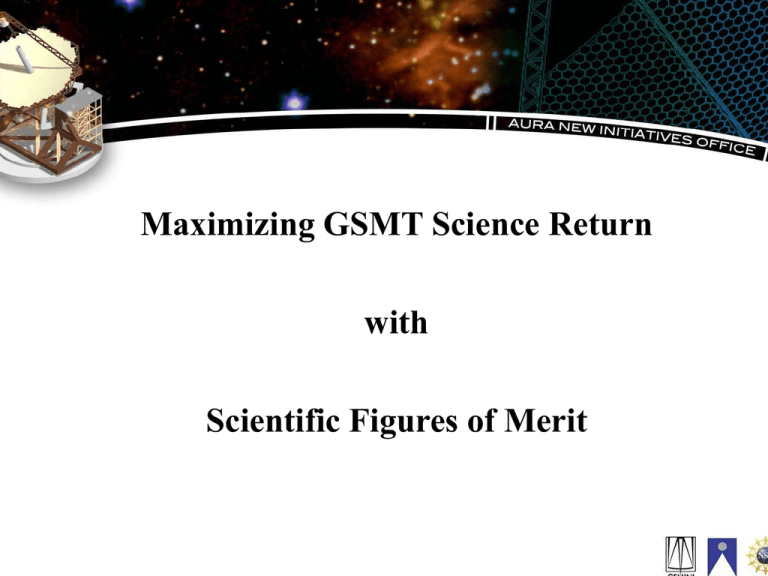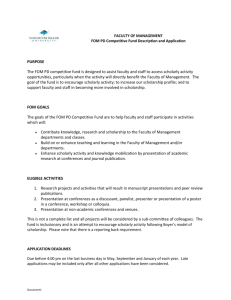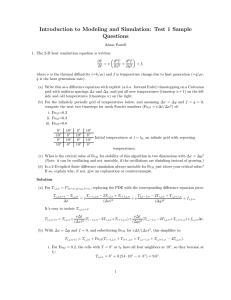Science Merit Functions
advertisement

Maximizing GSMT Science Return with Scientific Figures of Merit Maximizing value • Who are the interested parties? – Scientist users – Funding agencies • What constitutes value to them? – Scientific return – Cost • What gives greatest value? MAXIMUM SCIENTIFIC RETURN FOR COST Quantifying value Components of value • Performance – Requirements – Goals • Cost – Build – Operations • Schedule – First light – Operating life R I $$$ S Science K Science merit function Science merit function = ( Wi x FOMi ) • Figure of Merit (FOM) – For each capability, embodied as instrument + telescope – Quantitative, with analytical and numerical components – Function of instrument and telescope properties • Weight (W) – Scientific judgment call Example 1. GSMT spectroscopic capability Aperture Field of view Spatial resolution Resolved stellar populations 30 m 2-3 arcmin 10 milliarcsec Wavelength coverage Spectral resolution Instrument type 0.3-1.2 microns 1000’s OIR multislit Parameter Star formation 30 m < 10 arcmin 15 milliarcsec 0.3-2.2 microns > 2000 OIR MOS Example 2: CELT IR AO system emissivity • Cryogenic AO system at prime focus • Ultimate performance for emissivity • Negative impacts on telescope design, enclosure cost • Cryogenic AO system at Nasmyth focus • Quantifiably almost as good • Expect lower total observatory cost • Warm AO system at Nasmyth focus • Dramatically reduced performance • Low cost, maintains spatial resolution advantage • Trades against space platform sensitivity advantage What is the science mission? Type of mission impacts FOM, weights • Design reference mission – Total science program specified • Timely science mission – Maximize science achieved in initial period • Scientific capability mission – Instrument capabilities for wide range of potential science Example: UKIRT WFCAM program • WFCAM: widefield 1-2 m camera on 3.8 m telescope • Several large scale surveys over ~10 years (DRM) • Quick shallow surveys first (STM) • Selected deep fields done repeatedly (STM + DRM) • Instrument permits installation of custom filters (SCM) http://www.ukidss.org GSMT sample imaging capabilities • Enhanced seeing widefield imager – Gaussian profile – Tens of arcmin FOV • Narrow field coronagraph – Highest possible Strehl and dynamic range – FOV is arcseconds • Moderate field, diffraction limited imaging – Moderate Strehl over arcminute FOV Imaging FOM inputs: telescope • D, primary mirror diameter • TPtel ( ), throughput • ( , , t ), delivered image quality • S ( , , t ) , Strehl ratio • ( ) , emissivity • Etel , operating efficiency Imaging FOM inputs: instrument • TPinstrl ( ), throughput • DQE( ), detector quantum efficiency • , pixel sampling • , , wavelength coverage and resolution • R, D, read noise and dark current • Sc, scattered light susceptibility • Etel , system efficiency Imaging FOM inputs: multiplex advantages • , total solid angle field of view • n, number of simultaneous spectral channels Imaging FOM inputs: other science value factors • Timeliness • First light • Other facilities • Competition • Access • To facility • To data Enhanced native seeing imager • Science – Distribution of high redshift galaxies – Integrated properties of galaxies • Programmatic – Use at wavelengths where diffraction limit can’t be achieved – Use in less favorable conditions, e.g. thin cirrus • Implications for FOM – Slightly extended sources with some central concentration – Wavelength coverage is 1 m Enhanced native seeing imager Background limited, uncrowded field case Neglect Emissivity Strehl ratio Read noise, dark current Scattered light Programmatic terms Gather terms into a Figure of Merit for (integration time)-1 Enhanced native seeing imager Background limited, uncrowded field FOM 1/time [ (D2/2) • TPtel () • Etel] • Telescope [ • DQE • TPtinstr() • Etinstr • f(/) • f(n) • f(, ) ] Instrument • Track telescope, instrument separately • Some factors require simulations to determine appropriate formulations • Some factors may include weighting functions Formulation of image quality Poor conditions 1.0 arcsec Good conditions 0.5 0 10 , arcminutes 20 Delivered image quality vs field angle and conditions Optimizing / photometry Time detection 1 / 2 / 3 4 Weighting function for weight 1 0 0 MCAO regime , arcminutes 20 Tel, atmos rolloffs Enhanced native seeing imager trades Some performance (and cost) trades: – D, – , – TPtel () (coatings) – n (instrument complexity) – (optics complexity, coatings choices) Narrow field coronagraphic imager • Science – Discovery and characterization of planetary systems • Programmatic – Diffraction limited, very high Strehl at first light – Use in best seeing conditions • Implications for FOM – Wavelength coverage is 1 5 m – Treatment of systematic effects important – Independent of telescope design, AO implementation details Coronagraphic imager FOM additional inputs • d, subaperture size of primary • n, number of actuators on deformable mirror • , residual wavefront rms error • , speckle lifetime (site characteristic) • g, gain, ratio of peak intensity to halo level • R, amplitude reduction of primary core and halo by coronagraph Coronagraphic imager FOM Comparison with enhanced seeing imager: Neglect traditional seeing measure Include Strehl ratio S, emissivity Use additional terms to describe AO, coronagraph impacts Coronagraphic imager sensitivity FOM FOM for sensitivity (SNR): sensitivity [ D2 • TP • E • • DQE • -1 • f(/) • f(n) • f(, ) ]½ • [ S / (1-S) ] • [ D / d ]2 • [ 1/R ] • Includes “traditional” components, Strehl and gain advantages • Not yet in right units! • How to account for systematic effects? Coronagraphic imager systematics SNR limited by speckle structure in uncorrected halo – Pointlike – 100% amplitude modulation – Persist for time Variety of solutions – Decorrelation (large n, kHz AO update rate) – Simultaneous differential imaging (NICI) – PSF engineering, e.g. speckle sweeping – Data taking and reduction methods Coronagraphic imager final FOM • Characterize time – SNR relation by parameter • = 2 for photon noise limited system, less if residual systematic errors are significant 1/time ( previous expression ) Narrow field coronagraphic imager trades • Mirror segment size d • Speckle lifetime (site characteristics) • Emissivity and Strehl ratio S • error budget allocations • / with • Suppression of systematic error Wide field – narrow field comparisons FOV DIQ Tel geometry Tel optics Secondary Emissivity AO system Wide field Narrow field < 1 m 20 arcmin ~0.5 arcsec uncritical fast, complex large irrelevant Active secondary ~10E3 actuators 1 – 5 m 2 arcsec ~0.005 arcsec important slow, simple small important Ditto + DM w/ ~10E4 actuators Maximizing value, redux Return to performance, cost, schedule, risk mix: Is there a similar approach to maximizing value? Performance-cost index PCI = Science merit function / total cost (capital + ops) How to do optimization? Maximizing value, redux • Evaluate a few plausible approaches – Telescope type – Instruments • Trade studies for key parameters – Effect on SMF – Effect on cost • Creative tension between Scientist, Engineer, and Manager

